Sailing in the Isles of Western Scotland
While staying in Portrush, Northern Ireland for our ninth summer with my wife, Sumter, I received a text from my friend, Kevin Balmer, inviting me to join him in Scotland. He had sailed his sloop, Krystal, into the Hebrides about ten days earlier with the hope of rounding the north coast. But a series of terrific storms trapped him in Oban for about a week, ruining his plans. He wanted to return to his home port on the River Bann in Northern Ireland, and asked me to come crew with him. With Sumter’s blessing, I eagerly accepted.
On the 21st of July 2010, Kevin’s wife, Arline, who was on her way to County Down, took me to the airport in Belfast. I boarded a Flybe jet for the forty minute flight to Glasgow. The pilot made a Category II ILS approach and flaired out the landing not ten feet below heavy cloud and fog. I wondered how many such landings to absolute minimums he had made, but based my observation of Irish and Scottish weather, I’d guess he’d made a thousand of them.
After a quick cab ride to Queen Street railway station and a short wait, I was on the Scotrail to Oban. What impressed me most about Scotrail, being an American who couldn’t get around with a car, was that the train clearly was the major means of transportation for many Scots, some of whom boarded for no more than a ten minute ride from one village to another. It seemed as if the train either sped along, buried deep in tunnels or hanging precipitously on the edge of steep cliffs and ridges. 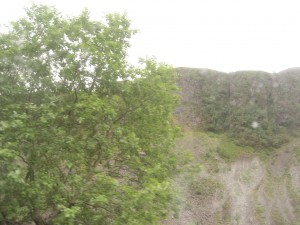 Spectacular views of deep valleys, waterfalls and loughs kept me entertained while I shared the ride with families, children going to summer camp, laborers on the way to work, and a few other folks, all speaking the local dialect.
Spectacular views of deep valleys, waterfalls and loughs kept me entertained while I shared the ride with families, children going to summer camp, laborers on the way to work, and a few other folks, all speaking the local dialect.
Upon arrival at Oban,Scotland,I called Kevin’s cell phone, hoping there might be some transportation arranged for my trip to Croabh Haven Marina, another fifteen miles away. Unfortunately, there was not, so I found a cab nearby. The cabbie was a woman, about thirty, who was very happy to take me, for a fare of 25.00 pounds. I soon learned she was from New Zealand and through a couple of marriages to British soldiers had ended up in Scotland. I did not know where she learned to drive, but as we tore down the winding narrow road in near skids around the curves, I guessed she was a product of Knockhill Racing Circuit.
Somehow surviving the wild ride—I didn’t tip—and taking my duffle in hand, I walked down the floating docks in search of Krystal. Not only did I find Kevin and his boat, but also there was Joe Slater’s sloop as well. Attracted by the sound of conversation and laughter, I found a merry craic underway in the marina’s pub. Along with Kevin were Joe and Carol Slater, Devlin and Greg. We had a fine meal along with several pints of Guinness, and I was ready for a good night’s rest in the stern cabin, all wrapped up in my sleeping bag, with buckets and barrels of rain drumming on the deck above.
Attracted by the sound of conversation and laughter, I found a merry craic underway in the marina’s pub. Along with Kevin were Joe and Carol Slater, Devlin and Greg. We had a fine meal along with several pints of Guinness, and I was ready for a good night’s rest in the stern cabin, all wrapped up in my sleeping bag, with buckets and barrels of rain drumming on the deck above.
Because tidal currents are so strong, it’s imperative that you sail with them and not against them. Consequently, Kevin was banging on my door at first light to say that it was time to go. Dressing quickly, I went topside where I found Kevin starting the engine. We took in our lines and got underway with Joe Slater in Sabine and his crew, Devlin and Greg, just astern. (Carol Slater had driven over from Ireland a few days earlier, via the Larne to Troon ferry, and was heading back home the same way.)
As we passed the jetty (pier in UK lingo), the sun rise burst forth in bright reds, piercing the clouds and haze of early chilly morning.There was just enough breeze to fill our sails, as we came round the point of land and turned south down Loch Melfort.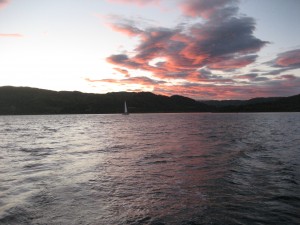
I shut down the engine, while Kevin went below and brought up some very welcomed coffee. August or not, steam rose abundantly from our cups in the cool morning breeze. The sea was calm with only slight ripples and we made good time in the light wind. Kevin’s next treat from the galley consisted of a few spoonfuls of hot but absolutely tasteless porridge, which was to be our breakfast. I was glad to have it but even happier that I’d had steak and Guinness pie last night at the marina. 
We continued sailing southward passing Luing and Shuna Island to our west. As the sun began to climb higher, its heat burned off the haze and soon produced a sunny day. We passed the southern tip of Luing at a good five knots in a warming wind. Nearing the southern point of the island of Scarba, we began to notice small eddies as the ebbing current swirled toward Corryvreckan. Kevin came up from the cabin to point out that this famous whirlpool occurs as tidal waters rush through the pass between the islands of Scarba and Jura, creating spectacular waves, hazardous to small craft.
 At the helm, I found the need to steer a more southeasterly course to counteract the powerful current. Cormorants knew there were schools of small fish in those waters. Several swam close by, diving as we neared them and coming up downstream, pulled by the ebbing tide.
At the helm, I found the need to steer a more southeasterly course to counteract the powerful current. Cormorants knew there were schools of small fish in those waters. Several swam close by, diving as we neared them and coming up downstream, pulled by the ebbing tide.
We sailed into the Sound of Jura. To our east lay the peninsula of Knapdale and its forest. To our west was the island of Jura, with its high rocky peaks, the “Paps of Jura”, outlined starkly against the sky. Joe Slater’s sloop was close behind us, its genoa and main filled with the strengthening wind. At about the midpoint of Jura the sound widened, and Kevin gave me a new course to steer so that we would remain near to the Knapdale mainland. It was a nearly perfect day, good wind, sunshine and a temperature of around sixty degrees Fahrenheit. In order to catch up, Joe kept his Sabine on a more southwesterly course, which gave him favorable winds. Soon Sabine came up even with us. Around noon, Kevin and I enjoyed sandwiches in the cockpit while taking in the view of Jura with Joe’s sailboat in the foreground. Soon Joe appeared to be ahead of us, in a lateral sense at least. It’s impossible for two or more sailboats to travel together and not get into an undeclared race. But Joe was not really ahead, Kevin said, smiling, because Sabine was now downwind of the course to Gigha Island, and Joe eventually would have to tact and thereby lose his lead.
Joe Slater’s sloop was close behind us, its genoa and main filled with the strengthening wind. At about the midpoint of Jura the sound widened, and Kevin gave me a new course to steer so that we would remain near to the Knapdale mainland. It was a nearly perfect day, good wind, sunshine and a temperature of around sixty degrees Fahrenheit. In order to catch up, Joe kept his Sabine on a more southwesterly course, which gave him favorable winds. Soon Sabine came up even with us. Around noon, Kevin and I enjoyed sandwiches in the cockpit while taking in the view of Jura with Joe’s sailboat in the foreground. Soon Joe appeared to be ahead of us, in a lateral sense at least. It’s impossible for two or more sailboats to travel together and not get into an undeclared race. But Joe was not really ahead, Kevin said, smiling, because Sabine was now downwind of the course to Gigha Island, and Joe eventually would have to tact and thereby lose his lead. 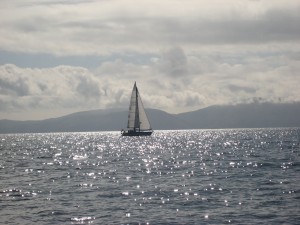
Smug in our confidence that we had the true lead, we continued south, with Islay off to the west. As we sailed close to the mainland, we soon came upon Gigha ahead. In less wind, we came around the tip of Knapdale and entered the Loch of Tarbert, passing several small rocky islets. East Tarbert Loch flowed into the narrow Sound of Gigha that runs between the Mull of Kintyere to the east and the island of Gigha to the west. Sure enough, Joe was tacking now, maybe even firing up his engine in order to make up for his fast reach downwind.
We, too, had to start our engine in the narrow sound. When we approached the midpoint of Gigha, Kevin lowered the main and furled the genoa. Passing offshore of the ferry dock, I turned right, heading west into the crescent-shaped little inlet at Ardminish. Although there were several sailboats on moorings, we found one not too far off shore. While Kevin went forward and lay down at the bow, line in hand, I eased Krystal up to the mooring buoy and stopped just within Kevin’s reach. He deftly passed the line through the pad eye at the top of the buoy and tied it off to the cleat at the bow. Then we both stood up and waved at Joe and his crew as they came in second place to a nearby mooring.
The next problem was getting ashore. Being close enough to our companions to shout, Kevin volunteered to put his dinghy in the water and row them in. We took turns pumping up the inflatable dinghy. Then, using a halyard from the mast, we lifted the boat from the deck and lowered it over the side. Kevin got out his oars, climbed in and rowed over to pick up Joe, Devlin and Greg. The gunwhale of the wee boat just barely stood above the water with the four of them in it, (rub-a-dub-dub) but the short ride in calm water was safe enough. It took about fifteen minutes for Kevin to row them to the dock and then come back for me.  When I climbed in with Kevin, the inflatable was nearly as sunk-down as when the four of them had been in it. Oh, well. Anyway, we arrived at the dock, joined the others and set out to explore the island.
When I climbed in with Kevin, the inflatable was nearly as sunk-down as when the four of them had been in it. Oh, well. Anyway, we arrived at the dock, joined the others and set out to explore the island.
The community was called Ardminish. It consisted of a wee general store, a few houses and the grander Gigha Hotel, complete with pub. Kevin, forever the athlete, wanted to take a run about the island. The rest of us opted to walk south to the botanical gardens, a half mile or so away. Although the island possessed lots of rustic and pastoral beauty, we were attacked by green flies along the road, that could bite in a most annoying manner. So, after our walk, the four of us chose to explore the hotel’s pub. The ale was fine, and we all enjoyed several, until Kevin arrived, and then we had to have another with him as well. Other sailors, and tourists who had arrived by the ferry, soon made the pub a lively place. I recall hearing German conversation mixed in with the Scottish brogues, and English and the Irish accents of my friends. I believe I was the only American there, and absolutely the only one with a southern drawl.
In the evening, after a good meal at the hotel, we wandered through the little store before returning to the pier. Kevin again volunteered to row us all back to the boats, but I insisted on doing the rowing when it came time to go back to Krystal. He chose to turn in early, but I decided to remain on deck, with a night cap of scotch, of course, to watch and photograph the spectacular sunset over Gigha. 
We were underway by eight the next morning, releasing Krystal from the mooring buoy and motoring south past the smaller adjoining island, Little Gigha. We soon raised our sails in the wider expanse of the Sound of Jura with the Mull of Kintyre still to the east. Many gannets, great white sea birds with black tipped wings and a wingspan of six feet, soared about us. When a gannet spots fish, he folds his wings and dives from as high as fifty feet above, crashing into the water and swimming as deep as twenty feet to catch his prey. Gannets have yellow heads, and I’ve wondered if it was that continual diving from fifty feet that turned that eventually gave them those yellow head feathers. Gannets never go to, or even fly over land, except at mating time in June. Many of them nest on Bull Point on the western end of Rathlin Island. Reportedly, there are as many as 250,000 pelagic birds—gannets, puffins, guillemots, razorbills and kittiwakes–that nest in the cliffs and crags at Bull Point. More remarkable than the sight of them is the sound of all their squawking. 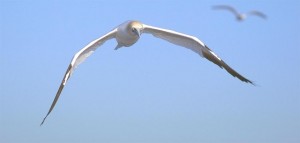
As we sailed down the Sound of Jura into the open sea of the North Channel, our destination was Church Bay near the eastern end of Rathlin. This L-shaped island is situated off the northeast corner of Ireland just across from Ballycastle, and has been an important stopover for ships and boats for centuries. Tidal currents in these waters is very swift, often as much as seven knots, making it necessary for sailing vessels in particular to wait at Rathlin for a favorable turn of the tide. Because it was a clear sunny day, we were able to see the high cliffs of Rathlin, and then the giant promontory Fairhead on the mainland, about fifteen miles away. Making about six knots, with Joe Slater and company a few miles behind, it was about noon when we rounded the eastern cliffs of Rathlin. Even though Rathlin Bay that lies between the island and the mainland is about five miles wide, powerful currents still swirl through. At the maximum ebb current, a whirlpool forms, which is called Slough Na Mare, meaning “swallow of the sea”. Coming between Rathlin and Fair Head we encountered very choppy waves that broke fiercely on Rue Point, the southern tip of Rathlin. 
In another thirty minutes, we entered Church Bay that lies within the protected crook of the boomerang-shaped island. There we tied up at the floating dock and walked down to the next berth to greet Sabine’s crew and take their lines. The five of us went ashore to see if the wee pub still had fine ale. Soon we were engaged in another “craic” that only Irish sailors can create. It had been a grand passage from the Scottish Isles. We enjoyed a fine supper at The Manor House and turned in, tired but happy. 
Our final day would involve a sail from Rathlin to our homeport, Seaton’s Marina on the River Bann at Coleraine. I’ll not tell of it because another of my webpages describes sailing from Rathlin to Seaton’s on a different day—a day of stormy weather, far more exciting than the pleasant, calm ride we had on this occasion.
For an American like me, accustomed to sailing the Gulf of Mexico and the Atlantic coast of the U. S., this voyage alongside the beautifully rugged islands of Scotland and the magnificent cliffs of Northern Ireland was a wonderful experience. With this article and the accompanying photos, I hope I’ve provided a taste of what it’s like. If you ever have the opportunity to make the same trip, don’t miss it.
–Steve Coleman
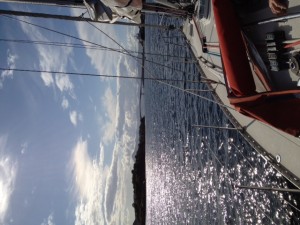
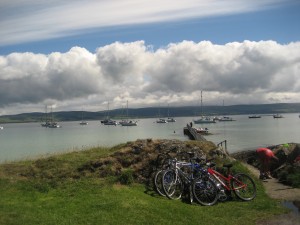
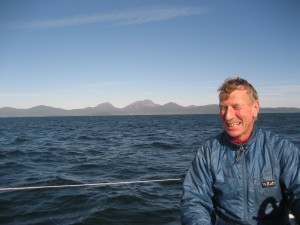
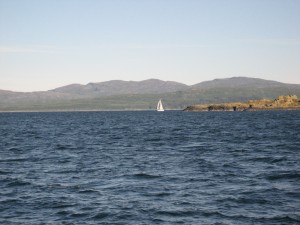
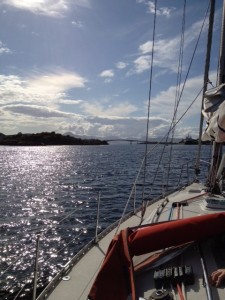

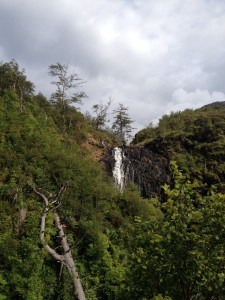
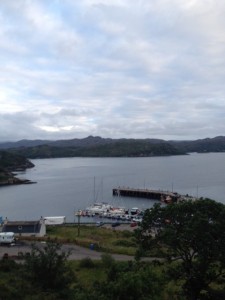


I am trying to get in touch with Kevin Balmer would you be able to help me please ?
Ian, I have given Kevin your email address, and I’m sure he will reply to you. It may take him a few days; he is not a big emailer. I hope you will read my novel set in Northern Ireland: The Navigator II: Irish Revenge It’s available at Amazon.co.uk
Cheers,
Steve